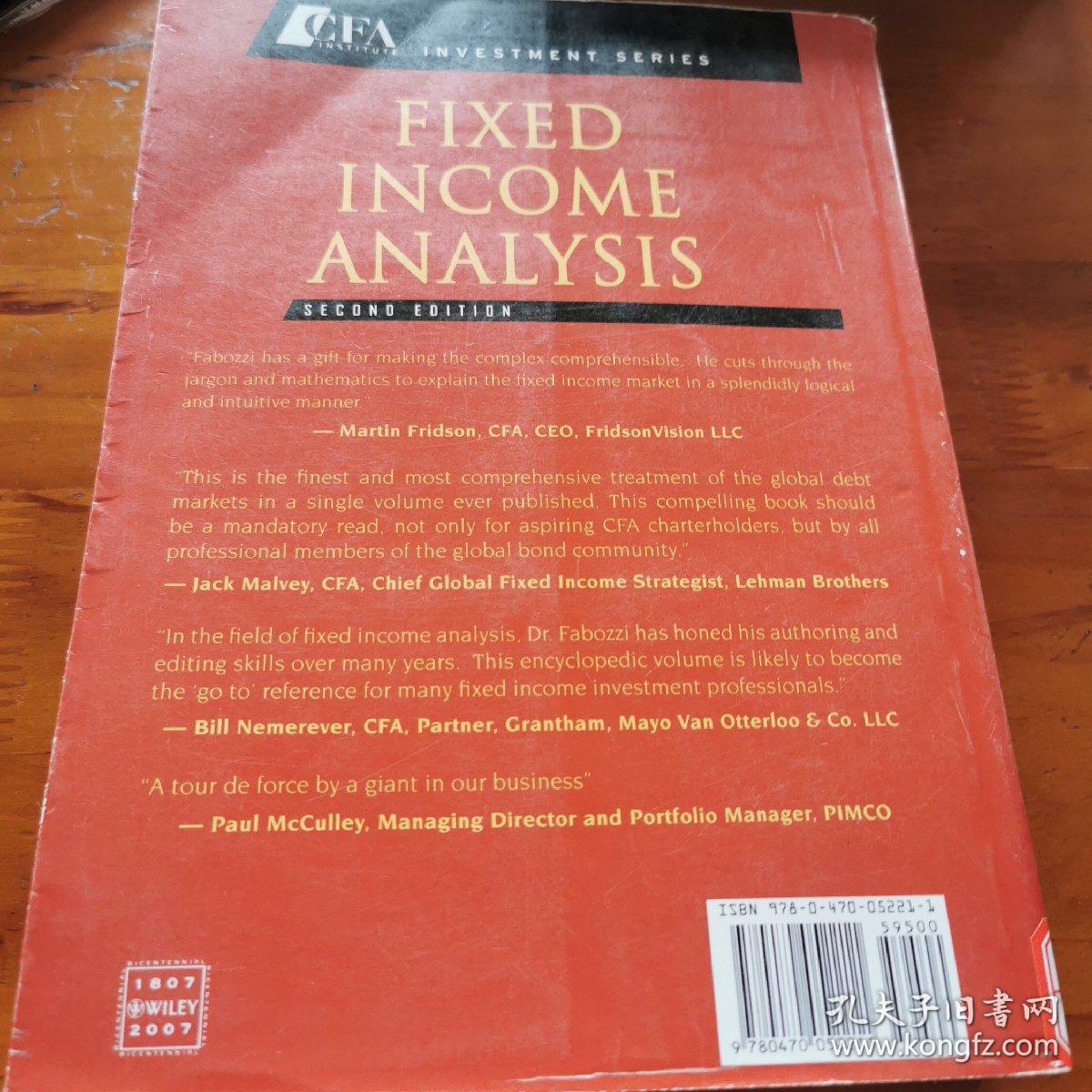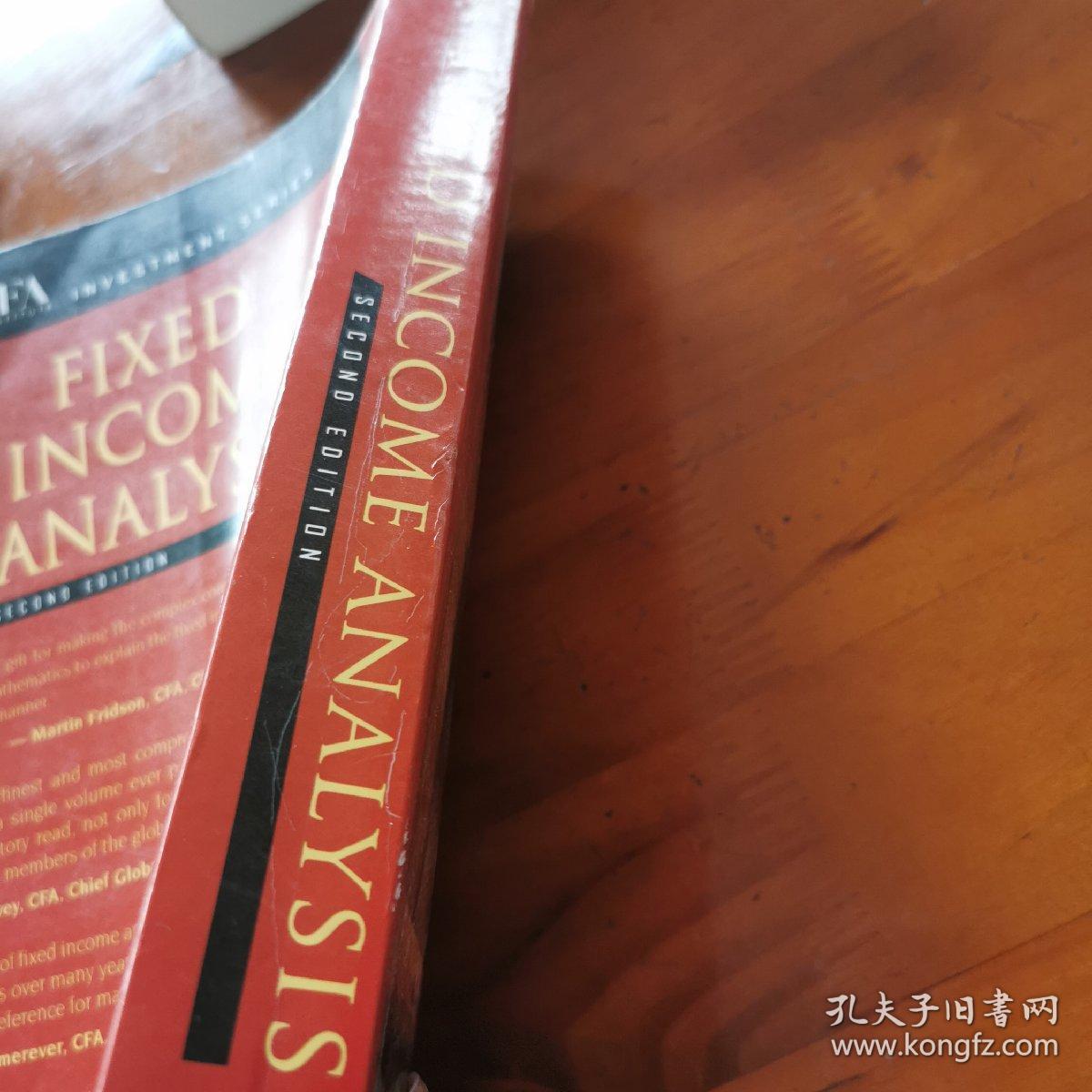
Fixed Income Analysis
¥ 180 1.9折 ¥ 959.1 八品
仅1件
湖北武汉
认证卖家担保交易快速发货售后保障
作者Frank J. Fabozzi(弗兰克·J·法博兹) 著
出版社Wiley
出版时间2007-01
版次2
装帧精装
上书时间2021-10-16
- 最新上架
商品详情
- 品相描述:八品
图书标准信息
- 作者 Frank J. Fabozzi(弗兰克·J·法博兹) 著
- 出版社 Wiley
- 出版时间 2007-01
- 版次 2
- ISBN 9780470052211
- 定价 959.10元
- 装帧 精装
- 开本 大16开
- 纸张 胶版纸
- 页数 768页
- 正文语种 英语
- 【内容简介】
-
IntheSecondEditionofFixedIncomeAnalysis,financialexpertFrankFabozziandateamofknowledgeablecontributorsprovidecompletecoverageofthemostimportantissuesinfixedincomeanalysis.
Now,inFixedIncomeAnalysisWorkbook,SecondEdition,Fabozzioffersyouawealthofpracticalinformationandexercisesthatwillsolidifyyourunderstandingofthetoolsandtechniquesassociatedwiththisdiscipline.Thiscomprehensivestudyguide -- whichparallelsthemainbookchapterbychapter -- containschallengingproblemsandacompletesetofsolutionsaswellasconciselearningoutcomestatementsandsummaryoverviews. - 【作者简介】
- FRANKJ.FABOZZI,PhD,CFA,CFP,isanAdjunctProfessorofFinanceandBectonFellowatYaleUniversity′sSchoolofManagement.HeisalsoEditoroftheJournalofPortfolioManagement,andaconsultant.
- 【目录】
- Foreword. Acknowledgments. Introduction. Note on RoundingDifferences. CHAPTER 1: Features of Debt Securities. I.Introduction. II. Indenture and Covenants. III. Maturity. IV. ParValue. V. Coupon Rate. VI. Provisions for Paying Off Bonds. VII.Conversion Privilege. VIII. Put Provision. IX. CurrencyDenomination. X. Embedded Options. XI. Borrowing Funds to PurchaseBonds. CHAPTER 2: Risks Associated with Investing in Bonds. I.Introduction. II. Interest Rate Risk. III. Yield Curve Risk. IV.Call and Prepayment Risk. V. Reinvestment Risk. VI. Credit Risk.VII. Liquidity Risk. VIII. Exchange Rate or Currency Risk. IX.Inflation or Purchasing Power Risk. X. Volatility Risk. XI. EventRisk. XII. Sovereign Risk. CHAPTER 3: Overview of Bond Sectors andInstruments. I. Introduction. II. Sectors of the Bond Market. III.Sovereign Bonds. IV. Semi-Government/Agency Bonds. V. State andLocal Governments. VI. Corporate Debt Securities. VII. Asset-BackedSecurities. VIII. Collateralized Debt Obligations. IX. PrimaryMarket and Secondary Market for Bonds. CHAPTER 4: UnderstandingYield Spreads. I. Introduction. II. Interest Rate Determination.III. U.S. Treasury Rates. IV. Yields on Non-Treasury Securities. V.Non-U.S. Interest Rates. VI. Swap Spreads. CHAPTER 5: Introductionto the Valuation of Debt Securities. I. Introduction. II. GeneralPrinciples of Valuation. III. Traditional Approach to Valuation.IV. The Arbitrage-Free Valuation Approach. V. Valuation Models.CHAPTER 6: Yield Measures, Spot Rates, and Forward Rates. I.Introduction. II. Sources of Return. III. Traditional YieldMeasures. IV. Theoretical Spot Rates. V. Forward Rates. CHAPTER 7:Introduction to the Measurement of Interest Rate Risk. I.Introduction. II. The Full Valuation Approach. III. PriceVolatility Characteristics of Bonds. IV. Duration. V. ConvexityAdjustment. VI. Price Value of a Basis Point. VII. The Importanceof Yield Volatility. CHAPTER 8: Term Structure and Volatility ofInterest Rates. I. Introduction. II. Historical Look at theTreasury Yield Curve. III. Treasury Returns Resulting from YieldCurve Movements. IV. Constructing the Theoretical Spot Rate Curvefor Treasuries. V. The Swap Curve (LIBOR Curve). VI. ExpectationsTheories of the Term Structure of Interest Rates. VII. MeasuringYield Curve Risk. VIII. Yield Volatility and Measurement. CHAPTER9: Valuing Bonds with Embedded Options. I. Introduction. II.Elements of a Bond Valuation Model. III. Overview of the BondValuation Process. IV. Review of How to Value an Option-Free Bond.V. Valuing a Bond with an Embedded Option Using the Binomial Model.VI. Valuing and Analyzing a Callable Bond. VII. Valuing a PutableBond. VIII. Valuing a Step-Up Callable Note. IX. Valuing a CappedFloater. X. Analysis of Convertible Bonds. CHAPTER 10:Mortgage-Backed Sector of the Bond Market. I. Introduction. II.Residential Mortgage Loans. III. Mortgage Passthrough Securities.IV. Collateralized Mortgage Obligations. V. StrippedMortgage-Backed Securities. VI. Nonagency ResidentialMortgage-Backed Securities. VII. Commercial Mortgage-BackedSecurities. CHAPTER 11: Asset-Backed Sector of the BondMarket. I.Introduction. II. The Securitization Process and Features of ABS.III. Home Equity Loans. IV. Manufactured Housing-Backed Securities.V. Residential MBS Outside the United States. VI. Auto Loan-BackedSecurities. VII. Student Loan-Backed Securities. VIII. SBALoan-Backed Securities. IX. Credit Card Receivable-BackedSecurities. X. Collateralized Debt Obligations. CHAPTER 12:ValuingMortgage-Backed and Asset-Backed Securities. I.Introduction. II. Cash Flow Yield Analysis. III. Zero-VolatilitySpread. IV. Monte Carlo Simulation Model and OAS. V. MeasuringInterest Rate Risk. VI. Valuing Asset-Backed Securities. VII.Valuing Any Security. CHAPTER 13: Interest Rate DerivativeInstruments. I. Introduction. II. Interest Rate Futures. III.Interest Rate Options. IV. Interest Rate Swaps. V. Interest RateCaps and Floors. CHAPTER 14: Valuation of Interest Rate DerivativeInstruments. I. Introduction. II. Interest Rate Futures Contracts.III. Interest Rate Swaps. IV. Options. V. Caps and Floors. CHAPTER15: General Principles of Credit Analysis. I. Introduction. II.Credit Ratings. III. Traditional Credit Analysis. IV. CreditScoring Models. V. Credit Risk Models. Appendix: Case Study.CHAPTER 16: Introduction to Bond Portfolio Management. I.Introduction. II. Setting Investment Objectives for Fixed-IncomeInvestors. III. Developing and Implementing a Portfolio Strategy.IV. Monitoring the Portfolio. V. Adjusting the Portfolio. CHAPTER17: Measuring a Portfolio's Risk Profile. I. Introduction. II.Review of Standard Deviation and Downside Risk Measures. III.Tracking Error. IV. Measuring a Portfolio's Interest Rate Risk. V.Measuring Yield Curve Risk. VI. Spread Risk. VII. Credit Risk.VIII. Optionality Risk for Non-MBS. IX. Risks of Investing inMortgage-Backed Securities. X. Multi-Factor Risk Models. CHAPTER18: Managing Funds against a Bond Market Index. I. Introduction.II. Degrees of Active Management. III. Strategies. IV. ScenarioAnalysis for Assessing Potential Performance. V. Using Multi-FactorRisk Models in Portfolio Construction. VI. Performance Evaluation.VII. Leveraging Strategies. CHAPTER 19: Portfolio Immunization andCash Flow Matching. I. Introduction. II. Immunization Strategy fora Single Liability. III. Contingent Immunization. IV. Immunizationfor Multiple Liabilities. V. Cash Flow Matching for MultipleLiabilities. CHAPTER 20: Relative-ValueMethodologies for GlobalCredit Bond Portfolio Management (by Jack Malvey). I. Introduction.II. Credit Relative-Value Analysis. III. Total Return Analysis. IV.Primary Market Analysis. V. Liquidity and Trading Analysis. VI.Secondary Trade Rationales. VII. Spread Analysis. VIII. StructuralAnalysis. IX. Credit Curve Analysis. X. Credit Analysis. XI. AssetAllocation/Sector Rotation. CHAPTER 21: International BondPortfolio Management (by Christopher B. Steward, J. Hank Lynch, andFrank J. Fabozzi). I. Introduction. II. Investment Objectives andPolicy Statements. III. Developing a Portfolio Strategy. IV.Portfolio Construction. Appendix. CHAPTER 22: Controlling InterestRate Risk with Derivatives (by Frank J. Fabozzi, ShrikantRamamurthy, and Mark Pitts). I. Introduction. II. ControllingInterest Rate Risk with Futures. III. Controlling Interest RateRisk with Swaps. IV. Hedging with Options. V. Using Caps andFloors. CHAPTER 23: HedgingMortgage Securities to Capture RelativeValue (by Kenneth B. Dunn, Roberto M. Sella, and Frank J. Fabozzi).I. Introduction. II. The Problem. III. Mortgage Security Risks. IV.How Interest Rates Change Over Time. V. Hedging Methodology. VI.Hedging Cuspy-Coupon Mortgage Securities. CHAPTER 24: CreditDerivatives in Bond Portfolio Management (by Mark J.P. Anson andFrank J. Fabozzi). I. Introduction. II. Market Participants. III.Why Credit Risk Is Important. IV. Total Return Swap. V. CreditDefault Products. VI. Credit Spread Products. VII. SyntheticCollateralized Debt Obligations. VIII. Basket Default Swaps. Aboutthe CFA Program. About the Author. About the Contributors.Index.
点击展开
点击收起
— 没有更多了 —

















以下为对购买帮助不大的评价